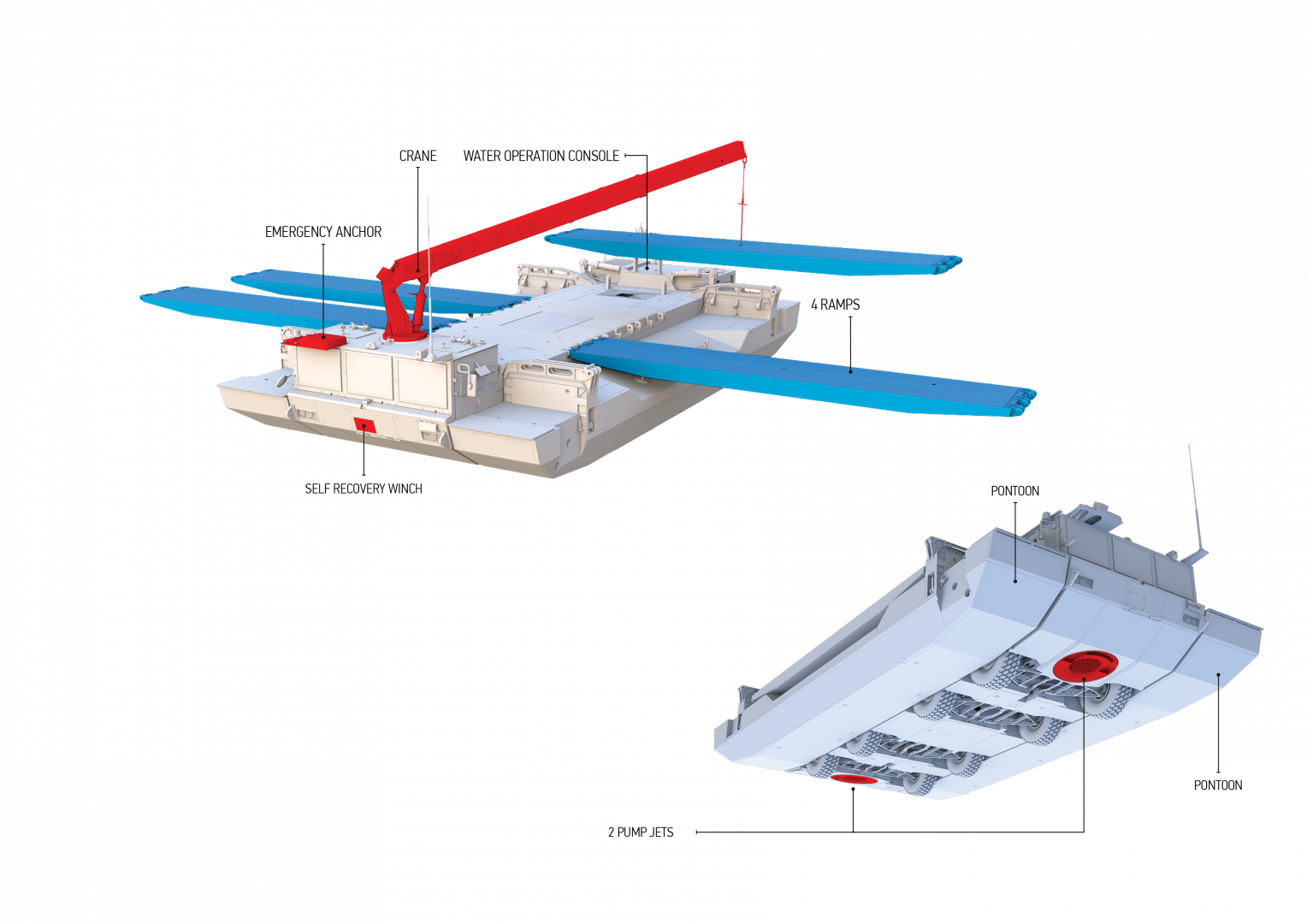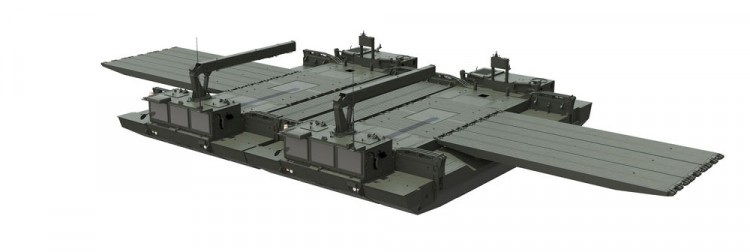OTTER RAPID DEPLOYABLE AMPHIBIOUS WET GAP CROSSING SYSTEM Overview
The OTTER is a bridge and ferry system designed for safe and fast transport of combat and logistic military vehicles in river crossing operations.
The OTTER system can also be used in natural disasters such as floods.
Being the only 8x8 vehicle in its class in the market today, the OTTER has unprecedented redundancy, operational capability in soft soil, cross-country mobility and amphibious performance.
Exceptional road and off-road performance: its all-wheel 8x8 driveline, central tire inflation and adjustable ride height control features provide an incomparable off-road driving performance and speed especially on loose, muddy and rough terrains. The ability to operate in soft soils allows for significantly less preparation on riverbanks to enter and exit the water. The all-wheel-steering feature minimizes the vehicle’s turning radius. The vertical obstacle and trench crossing capabilities are also superior due to the shorter distance between axles in the 8x8 concept. Moreover, the 8x8 configuration gives a maximum axle load of around 9 tons, the significantly low ground pressure providing longer wheel life due to less wear. The OTTER can cope with 60% gradient and 30% side slopes.
360° manoeuvres in high river currents: the OTTER system has two water pump jets that provide advanced water operation capabilities enabling the vehicle to carry out 360° manoeuvres within high river currents such as pivot turns and side moves. During water operations the axles are retracted in order to decrease the water drag.
In the ferry role, a single OTTER system can transport MLC 21 tracked vehicles. Two OTTER systems can be coupled together forming a pontoon that can transport an MLC 85 T vehicle. By coupling three systems ramp to ramp, up to MLC 120 W vehicles can be transported over wet gaps. As well as its role as a ferry, 8 OTTER systems can be combined together ramp to ramp to form a 100 m long bridge capable of carrying MLC 85 T and MLC 120 W vehicles. For specific missions, numerous OTTERs can be coupled together to cross wider distances.

SINGLE OTTER FERRY MODE / MLC 21 T

As its ferry role, a single OTTER system can transport MLC 21 tracked vehicles.
2 OTTER FERRY MODE / MLC 85 T

Two OTTER systems can be coupled together pontoon to pontoon and can transport a MLC85 T vehicle.
3 OTTER FERRY MODE / MLC 120 W

By coupling three systems ramp to ramp, up to MLC120 W vehicle can be transported over a wet gaps.
100 M BRIDGE CONFIGURATION WITH 8 OTTER / MLC 85 T & MLC 120 W

As well as its role as a ferry,
8 each OTTER systems can be combined together ramp to ramp to construct a 100 m long bridge which is capable of carrying MLC85 T & MLC120 W vehicles. For specific missions, numerous OTTERs can be coupled together to cross wider distances.
In terms of self-sufficiency, the OTTER can carry four ramps on a single system, which eliminates the need for additional logistic vehicles. The OTTER is also fitted with a self-recovery winch, which recovers the vehicle or any other system especially in soft terrains.
Another unique feature of the OTTER is its crew survivability. The crew cabin that accommodates 3 personnel features ballistic armour protection, automatic fire suppression and NBC protection systems. The vehicle is fitted with a distributed vetronics architecture, which includes an on board diagnostics system (CAN-BUS structure). Front and rear cameras enhance situational awareness.
The vehicle is also equipped with a standard anchoring mechanism (both emergency and land anchoring systems). In case of failure or damage, the OTTER’s 8x8 driveline concept serves by far the best for redundancy requirements. In case of loss of several driveline items (wheels, brakes, axles etc.), the vehicle does not lose operational capability whereas 4x4 vehicles do.
The OTTER is an operationally proven bridge and ferry system designed for Turkish Land Forces combat engineers, using the latest technologies, and has actively been in service since 2012. The OTTER design is certified according to NATO standards, and satisfies all up to date NATO requirements such as defined river states, deployment and transportation. Rapid assault wet gap crossing at lowest logistic burden and saline operation capabilities are other significant advantages of the system.
